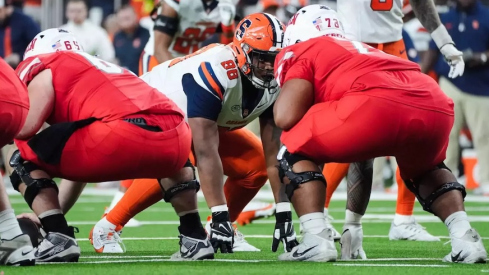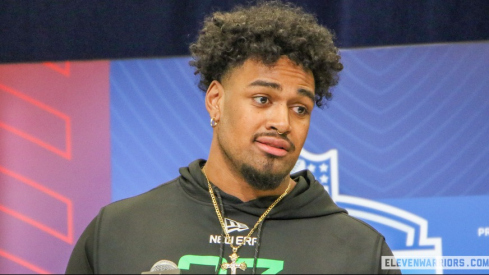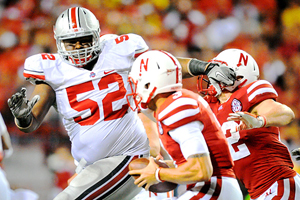 Nothing better than the Big Guys in coverage.
Nothing better than the Big Guys in coverage.Now that I have covered the historical impetus behind the zone blitz, it is time to examine basic zone blitz concepts. Broadly speaking, zone blitzes fall within three categories: field blitzes, inside blitzes, and boundary blitzes. I will look at each in turn.
Field Blitzes
The 'fire zone' (aka 'NCAA') blitz to the field (the wide side of the field if the offense is on a hash mark) with coverage rotating to the blitz is perhaps the most common zone blitz.

In essence, the strong side linebackers (SAM and Mike) blitz, while the defensive line slants to the gap away from the blitz. The backside defensive end then drops in coverage. The basic principles in this blitz are so sound that nearly every team runs some version. The defense accomplishes the basic goal of providing overload pressure to force the quarterback to get rid of the football. The defense minimizes its risks by bringing pressure from the field--generally the side an offense will attack--and by only bringing five rushers, allowing it to play six defenders in zone coverage.
A defense can also make a small adjustment by simply exchanging a linebacker and strong safety's responsibilities to run the same blitz while giving the offense a different look, changing the offense's aiming point.
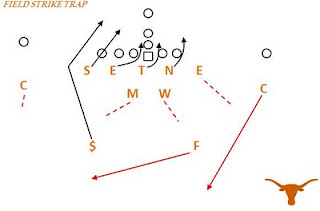
Interior Zone Blitzes
Of course, a field blitz is not the only option, however. Teams also often bring interior zone blitzes. This can feature not only two inside linebackers but also a safety. For instance, here is Dick LeBeau's 'inside fire zone.'
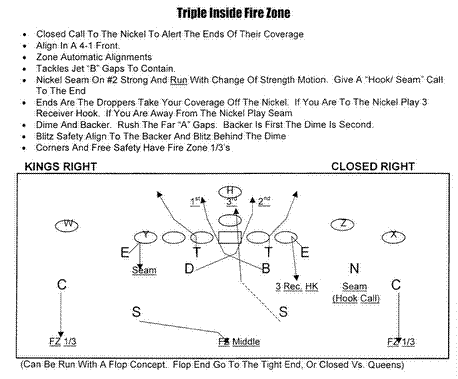
Again, this play attempts to overload the offense. Specifically, the defense attacks with five blitzers versus three offensive linemen. In so doing, the defense also leaves the offense's best pass protectors--the offensive tackles--with no one to block. The defense again has the base three deep zone shell while covering the hot lanes with the dropping ends. Inside pressure leaves the quarterback nowhere to turn, again forcing a short pass or incompletion.
As with the other rubrics, this blitz is not exhaustive but merely illustrative. For instance, a defense can also simply cross the two inside linebackers, bring the two inside linebackers through their assigned B gaps, or trade responsibilities amongst the linebackers. All are an attempt to accomplish the same goal outlined above.
Boundary Zone Blitzes
Finally, teams will also bring zone blitzes from the boundary. The most basic example is that teams will use the fire zone blitz above to the boundary instead of the field.
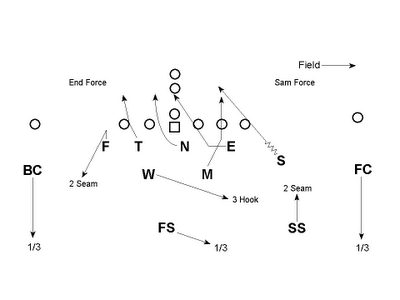
As with this blitz to the field, the defensive line slants away from the blitz, while the coverages rotates towards it. The defense is attempting to attack the offense's weak side where it naturally has less blockers to handle the overload rush. With this blitz, the defensive end will ensure force to the field against the run before dropping into the seam. A related blitz is a zone blitz twist towards the offense's open (non TE side).
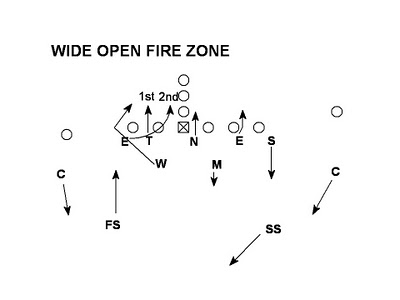
The defense is again trying to overwhelm the offense's weak side in a slightly different manner. Again, the offense only has 2 1/2 blockers (Guard, Tackle, and either the Center or Running back) to handle three blitzers. The offense must also handle the twist. Depending on the blocking scheme, the center is going to have to wait upon the defensive end while the guard and tackle attempt to slide out, or the guard and tackle must quickly come down upon the defensive linemen while the running back attempts to pick up the blitzing Will. In any event, it provides a defensive coordinator another tool to attack the offense to its weak point i(n terms of numbers).
Zone Blitz Coverages
As diagrammed above, the typical coverage behind the zone blitz is a three deep three under. The basic rationale is simply to defend against the offense hitting a big play against the blitz. Elsewise, the defense may simply have too much open field deep. It may leave holes underneath, but at least the defense has a typical three deep with defensive backs tutored in playing that coverage. Plus, as discussed, a defense is often comfortable with the offense completing an underneath pass and allowing the zone defenders to come up and make a tackle short of the first down.
Teams will switch up this coverage to try and catch offenses off balance, however. One example is a form of cover 2 intended to "trap" the offense. (see Texas Field strike trap cover 2 above). The defense has two defenders playing one half of the field with four underneath defenders.
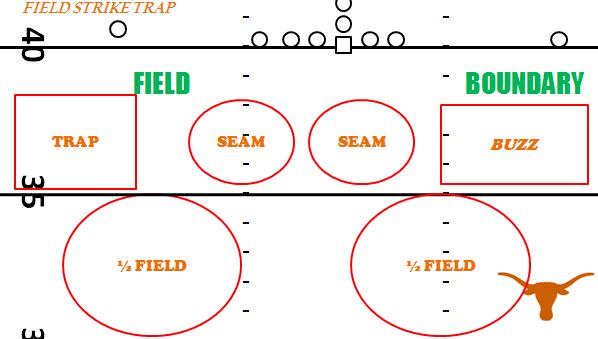
This coverage will leave zone holes, but is intended to have defenders precisely where they would not be for an offense expecting a middle of the field safety. The name of the game here, then, is to confusion and trying to force the offense to make a mistake.
Conclusion
This is by no means an exhaustive list of zone blitz calls but instead intended to provide the basic framework under which defenses will employ zone blitzes. As with all, the goal is to both overload the offensive protection while simultaneously guarding against a big play, forcing an offense to dump the ball underneath. In other words, the zone blitz's goal is to take the boom and bust cycle out of blitzing while ideally leaving only upside.
